SKODA ROOMSTER 2007 1.G Owner's Manual
Manufacturer: SKODA, Model Year: 2007, Model line: ROOMSTER, Model: SKODA ROOMSTER 2007 1.GPages: 248, PDF Size: 46.44 MB
Page 191 of 248
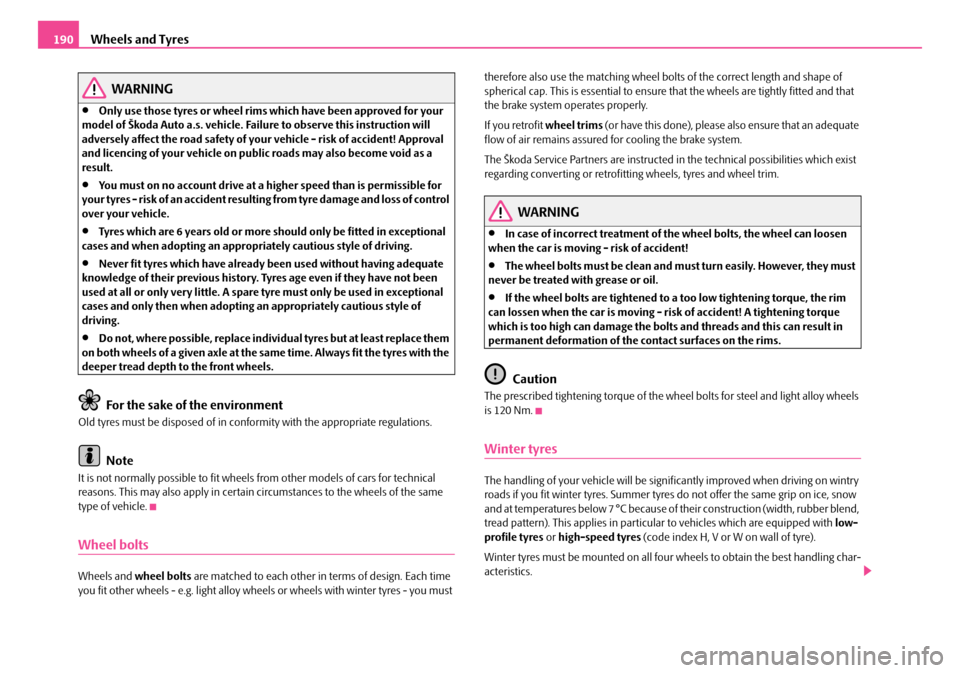
Wheels and Tyres190
WARNING
•Only use those tyres or wheel rims which have been approved for your model of Škoda Auto a.s. vehicle. Failure to observe this instruction will adversely affect the road safety of your vehicle - risk of accident! Approval and licencing of your vehicle on public roads may also become void as a result.
•You must on no account drive at a higher speed than is permissible for y our t yre s - ris k of a n ac cid e n t re su lti ng fro m ty re d a m ag e a nd lo ss o f c ont rol over your vehicle.
•Tyres which are 6 years old or more should only be fitted in exceptional cases and when adopting an appropriately cautious style of driving.
•Never fit tyres which have already been used without having adequate knowledge of their previous history. Ty res age even if they have not been used at all or only very little. A spare tyre must only be used in exceptional cases and only then when adopting an appropriately cautious style of driving.
•Do not, where possible, replace indivi dual tyres but at least replace them on both wheels of a given axle at the same time. Always fit the tyres with the deeper tread depth to the front wheels.
For the sake of the environment
Old tyres must be disposed of in conformity with the appropriate regulations.
Note
It is not normally possible to fit wheels from other models of cars for technical reasons. This may also apply in certain circumstances to the wheels of the same type of vehicle.
Wheel bolts
Wheels and wheel bolts are matched to each other in terms of design. Each time you fit other wheels - e.g. light alloy wheels or wheels with winter tyres - you must
therefore also use the matching wheel bolts of the correct length and shape of spherical cap. This is essent ial to ensure that the wheels are tightly fitted and that the brake system operates properly.
If you retrofit wheel trims (or have this done), please also ensure that an adequate flow of air remains assured for cooling the brake system.
The Škoda Service Partners are instructed in the technical possibilities which exist regarding converting or retrofitti ng wheels, tyres and wheel trim.
WARNING
•In case of incorrect treatment of the wheel bolts, the wheel can loosen when the car is moving - risk of accident!
•The wheel bolts must be clean and must turn easily. However, they must never be treated with grease or oil.
•If the wheel bolts are tightened to a too low tightening torque, the rim can lossen when the car is moving - risk of accident! A tightening torque which is too high can damage the bolts and threads and this can result in permanent deformation of the contact surfaces on the rims.
Caution
The prescribed tightening torque of the wh eel bolts for steel and light alloy wheels is 120 Nm.
Winter tyres
The handling of your vehicle will be significantly improved when driving on wintry roads if you fit winter tyres. Summer tyres do not offer the same grip on ice, snow and at temperatures below 7 °C because of their construction (width, rubber blend, tread pattern). This applies in particul ar to vehicles which are equipped with low- profile tyres or high-speed tyres (code index H, V or W on wall of tyre).
Winter tyres must be mounted on all four wheels to obtain the best handling char- acteristics.
NKO A05R 20 MR08.book Page 190 Wednesday, March 28, 2007 9:42 AM
Page 192 of 248
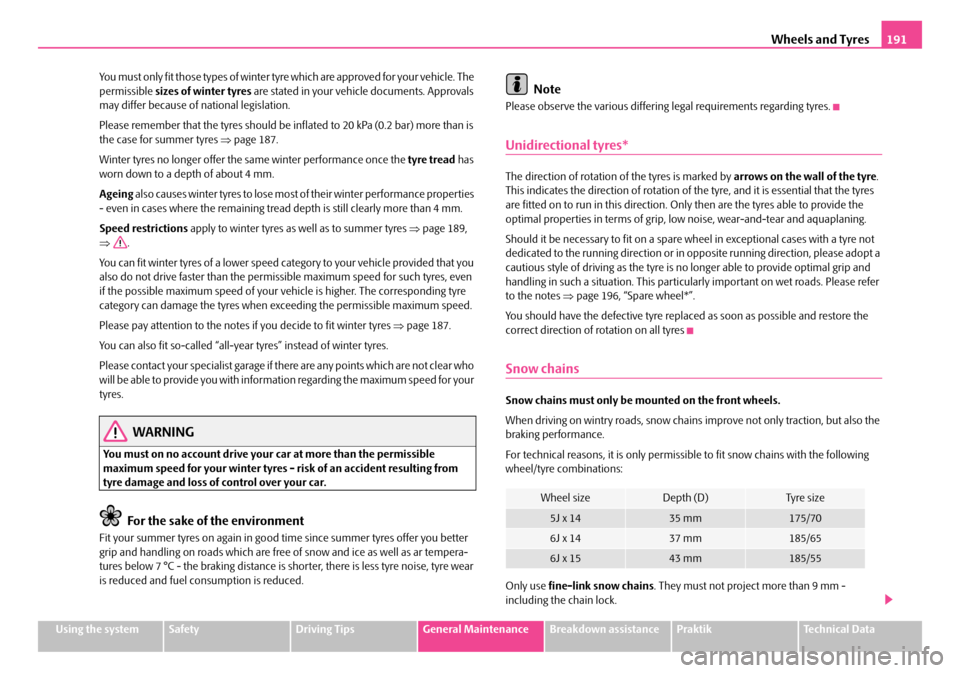
Wheels and Tyres191
Using the systemSafetyDriving TipsGeneral MaintenanceBreakdown assistancePraktikTechnical Data
You must only fit those types of winter tyre which are approved for your vehicle. The permissible sizes of winter tyres are stated in your vehicle documents. Approvals may differ because of national legislation.
Please remember that the tyres should be in flated to 20 kPa (0.2 bar) more than is the case for summer tyres ⇒page 187.
Winter tyres no longer offer the same winter performance once the tyre tread has worn down to a depth of about 4 mm.
Ageing also causes winter tyres to lose most of their winter performance properties - even in cases where the remaining tread depth is still clearly more than 4 mm.
Speed restrictions apply to winter tyres as well as to summer tyres ⇒page 189, ⇒ .
You can fit winter tyres of a lower speed ca tegory to your vehicle provided that you also do not drive faster than the permis sible maximum speed for such tyres, even if the possible maximum speed of your ve hicle is higher. The corresponding tyre category can damage the tyres when ex ceeding the permissible maximum speed.
Please pay attention to the notes if you decide to fit winter tyres ⇒page 187.
You can also fit so-called “all-year tyres” instead of winter tyres.
Please contact your specialist garage if there are any points which are not clear who will be able to provide you with information regarding the maximum speed for your tyres.
WARNING
You must on no account drive your car at more than the permissible maximum speed for your winter tyres - risk of an accident resulting from tyre damage and loss of control over your car.
For the sake of the environment
Fit your summer tyres on again in good time since summer tyres offer you better grip and handling on roads which are free of snow and ice as well as ar tempera-tures below 7 °C - the braking distance is shor ter, there is less tyre noise, tyre wear is reduced and fuel consumption is reduced.
Note
Please observe the various differing legal requirements regarding tyres.
Unidirectional tyres*
The direction of rotation of the tyres is marked by arrows on the wall of the tyre. This indicates the direction of rotation of the tyre, and it is essential that the tyres are fitted on to run in this direction. Only then are the tyres able to provide the optimal properties in terms of grip, lo w noise, wear-and-tear and aquaplaning.
Should it be necessary to fit on a spare wheel in exceptional cases with a tyre not dedicated to the running dire ction or in opposite running direction, please adopt a cautious style of driving as the tyre is no longer able to provide optimal grip and handling in such a situation. This particularly important on wet roads. Please refer to the notes ⇒page 196, “Spare wheel*”.
You should have the defective tyre replac ed as soon as possible and restore the correct direction of rotation on all tyres
Snow chains
Snow chains must only be mounted on the front wheels.
When driving on wintry roads, snow chains improve not only traction, but also the braking performance.
For technical reasons, it is only permissi ble to fit snow chains with the following wheel/tyre combinations:
Only use fine-link snow chains. They must not project more than 9 mm - including the chain lock.
Wheel sizeDepth (D)Ty re s i z e
5J x 1435 mm175/70
6J x 1437 mm185/65
6J x 1543 mm185/55
NKO A05R 20 MR08.book Page 191 Wednesday, March 28, 2007 9:42 AM
Page 193 of 248
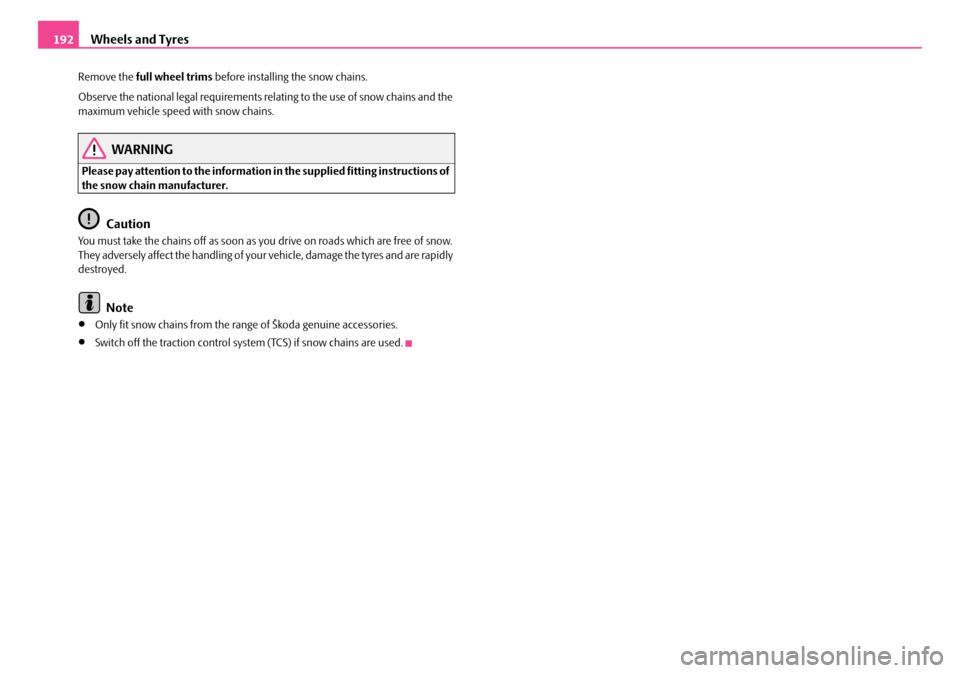
Wheels and Tyres192
Remove the full wheel trims before installing the snow chains.
Observe the national legal requirements rela ting to the use of snow chains and the maximum vehicle speed with snow chains.
WARNING
Please pay attention to the information in the supplied fitting instructions of the snow chain manufacturer.
Caution
You must take the chains off as soon as you drive on roads which are free of snow. They adversely affect the handling of your vehicle, damage the tyres and are rapidly destroyed.
Note
•Only fit snow chains from the range of Škoda genuine accessories.
•Switch off the traction control system (TCS) if snow chains are used.
NKO A05R 20 MR08.book Page 192 Wednesday, March 28, 2007 9:42 AM
Page 194 of 248
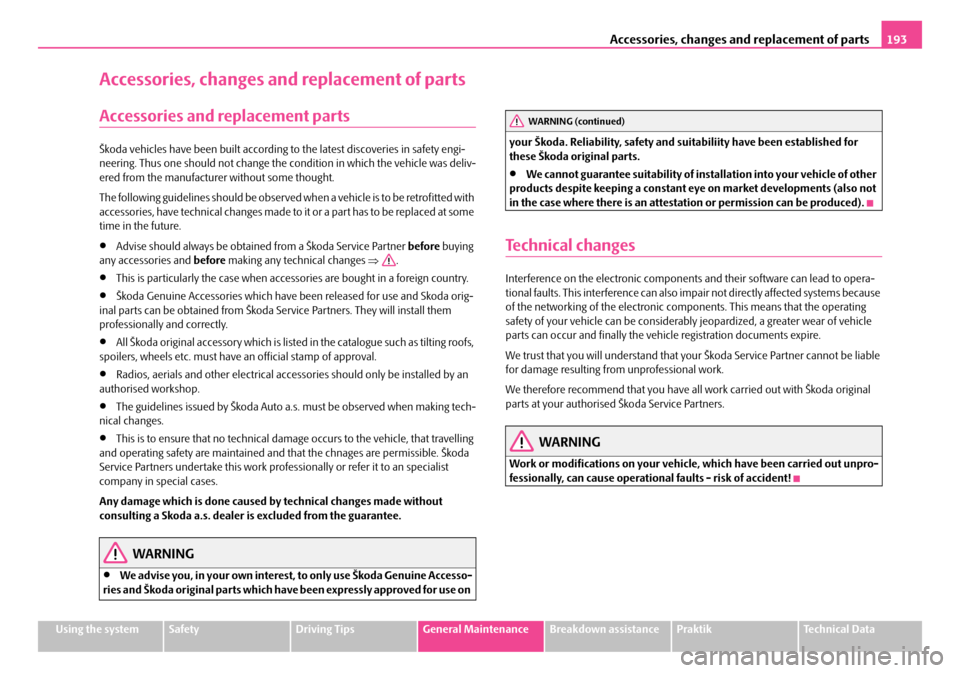
Accessories, changes and replacement of parts193
Using the systemSafetyDriving TipsGeneral MaintenanceBreakdown assistancePraktikTechnical Data
Accessories, changes and replacement of parts
Accessories and replacement parts
Škoda vehicles have been built according to the latest discoveries in safety engi- neering. Thus one should no t change the condition in which the vehicle was deliv- ered from the manufacturer without some thought.
The following guidelines should be observed when a vehicle is to be retrofitted with accessories, have technical ch anges made to it or a par t has to be replaced at some time in the future.
•Advise should always be obtained from a Škoda Service Partner before buying any accessories and before making any technical changes ⇒.
•This is particularly the case when accessories are bought in a foreign country.
•Škoda Genuine Accessories which have been released for use and Skoda orig- inal parts can be obtained from Škoda Se rvice Partners. They will install them professionally and correctly.
•All Škoda original accessory which is listed in the catalogue such as tilting roofs, spoilers, wheels etc. must have an official stamp of approval.
•Radios, aerials and other electrical accessories should only be installed by an authorised workshop.
•The guidelines issued by Škoda Auto a.s. must be observed when making tech- nical changes.
•This is to ensure that no technical damage occurs to the vehicle, that travelling and operating safety are maintained and that the chnages are permissible. Škoda Service Partners undertake this work professionally or refer it to an specialist company in special cases.
Any damage which is done caused by technical changes made without consulting a Skoda a.s. dealer is excluded from the guarantee.
WARNING
•We advise you, in your own interest, to only use Škoda Genuine Accesso- ries and Škoda original parts which have been expressly approved for use on
your Škoda. Reliability, safety and su itabiliity have been established for these Škoda original parts.
•We cannot guarantee suitability of installation into your vehicle of other products despite keeping a constant ey e on market developments (also not in the case where there is an attestation or permission can be produced).
Technical changes
Interference on the electronic components and their software can lead to opera-tional faults. This interference can also impair not directly affected systems because of the networking of the electronic co mponents. This means that the operating safety of your vehicle can be considerably jeopardized, a greater wear of vehicle parts can occur and finally the vehi cle registration documents expire.
We trust that you will understand that yo ur Škoda Service Partner cannot be liable for damage resulting from unprofessional work.
We therefore recommend that you have a ll work carried out with Škoda original parts at your authorised Škoda Service Partners.
WARNING
Work or modifications on your vehicle, which have been carried out unpro-fessionally, can cause operational faults - risk of accident!
WARNING (continued)
NKO A05R 20 MR08.book Page 193 Wednesday, March 28, 2007 9:42 AM
Page 195 of 248
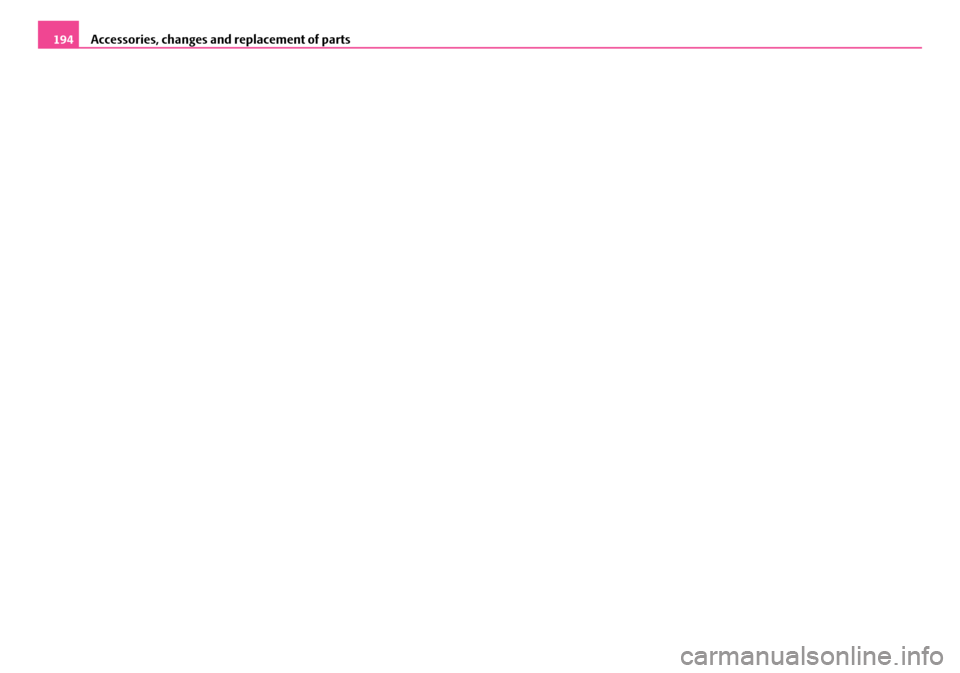
Accessories, changes and replacement of parts194
NKO A05R 20 MR08.book Page 194 Wednesday, March 28, 2007 9:42 AM
Page 196 of 248
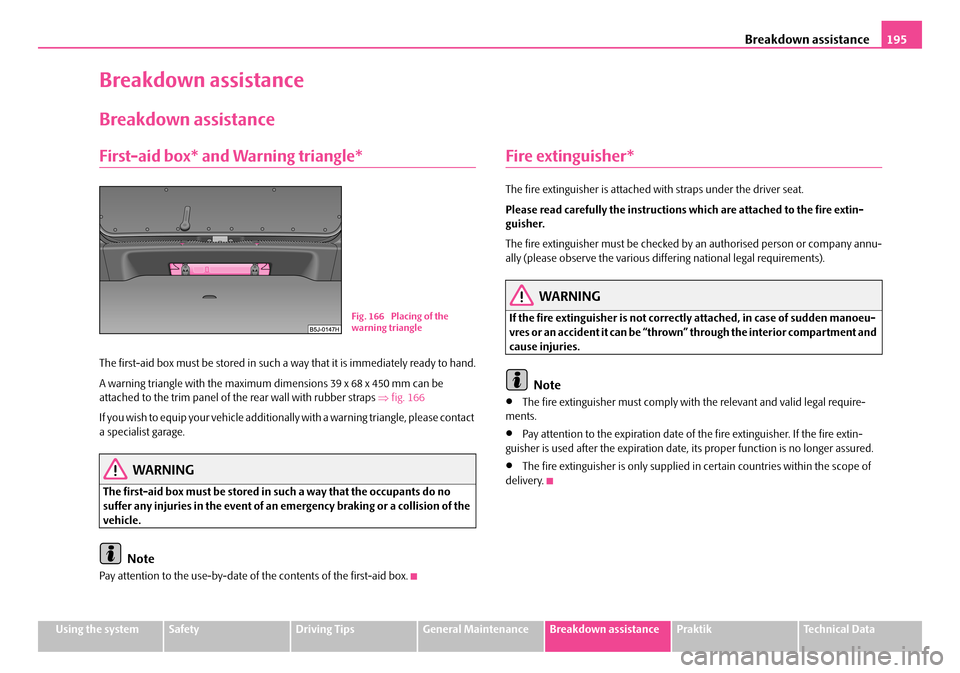
Breakdown assistance195
Using the systemSafetyDriving TipsGeneral MaintenanceBreakdown assistancePraktikTechnical Data
Breakdown assistance
Breakdown assistance
First-aid box* and Warning triangle*
The first-aid box must be stored in such a way that it is immediately ready to hand.
A warning triangle with the maximum dimensions 39 x 68 x 450 mm can be attached to the trim panel of th e rear wall with rubber straps ⇒fig. 166
If you wish to equip your ve hicle additionally with a warning triangle, please contact a specialist garage.
WARNING
The first-aid box must be stored in such a way that the occupants do no suffer any injuries in the event of an emergency braking or a collision of the vehicle.
Note
Pay attention to the use-by-date of the contents of the first-aid box.
Fire extinguisher*
The fire extinguisher is attached with straps under the driver seat.
Please read carefully the instructions which are attached to the fire extin- guisher.
The fire extinguisher must be checked by an authorised person or company annu- ally (please observe the various differing national legal requirements).
WARNING
If the fire extinguisher is not correctly attached, in case of sudden manoeu- vres or an accident it can be “thrown” through the interior compartment and cause injuries.
Note
•The fire extinguisher must comply with the relevant and valid legal require- ments.
•Pay attention to the expiration date of the fire extinguisher. If the fire extin-guisher is used after the expiration date, its proper function is no longer assured.
•The fire extinguisher is only supplied in certain countries within the scope of delivery.
Fig. 166 Placing of the warning triangle
NKO A05R 20 MR08.book Page 195 Wednesday, March 28, 2007 9:42 AM
Page 197 of 248
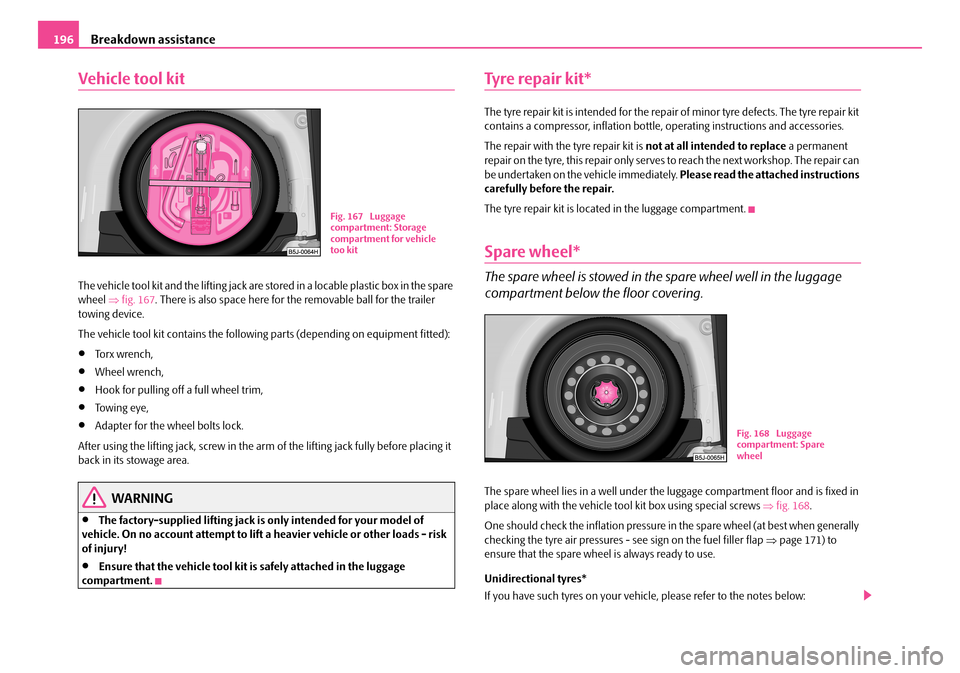
Breakdown assistance196
Vehicle tool kit
The vehicle tool kit and the lifting jack are stored in a locable plastic box in the spare wheel ⇒fig. 167. There is also space here for the removable ball for the trailer towing device.
The vehicle tool kit contains the following parts (depending on equipment fitted):
•Torx wrench,
•Wheel wrench,
•Hook for pulling off a full wheel trim,
•Towing eye,
•Adapter for the wheel bolts lock.
After using the lifting jack, screw in the arm of the lifting jack fully before placing it back in its stowage area.
WARNING
•The factory-supplied lifting jack is only intended for your model of vehicle. On no account attempt to lift a heavier vehicle or other loads - risk of injury!
•Ensure that the vehicle tool kit is safely attached in the luggage compartment.
Tyre repair kit*
The tyre repair kit is intended for the repair of minor tyre defects. The tyre repair kit contains a compressor, inflation bottle, operating instructions and accessories.
The repair with the tyre repair kit is not at all intended to replace a permanent re pair on the tyre, this repai r only s er v es to reach the next w orks hop. T he re pa ir can be undertaken on the vehicle immediately. Please read the attached instructions carefully before the repair.
The tyre repair kit is locate d in the luggage compartment.
Spare wheel*
The spare wheel is stowed in the spare wheel well in the luggage
compartment below the floor covering.
The spare wheel lies in a well under the luggage compartment floor and is fixed in place along with the vehicle tool kit box using special screws ⇒fig. 168.
One should check the inflation pressure in the spare wheel (at best when generally checking the tyre air pressures - see sign on the fuel filler flap ⇒page 171) to ensure that the spare wheel is always ready to use.
Unidirectional tyres*
If you have such tyres on your vehicle, please refer to the notes below:
Fig. 167 Luggage compartment: Storage compartment for vehicle too kit
Fig. 168 Luggage compartment: Spare wheel
NKO A05R 20 MR08.book Page 196 Wednesday, March 28, 2007 9:42 AM
Page 198 of 248
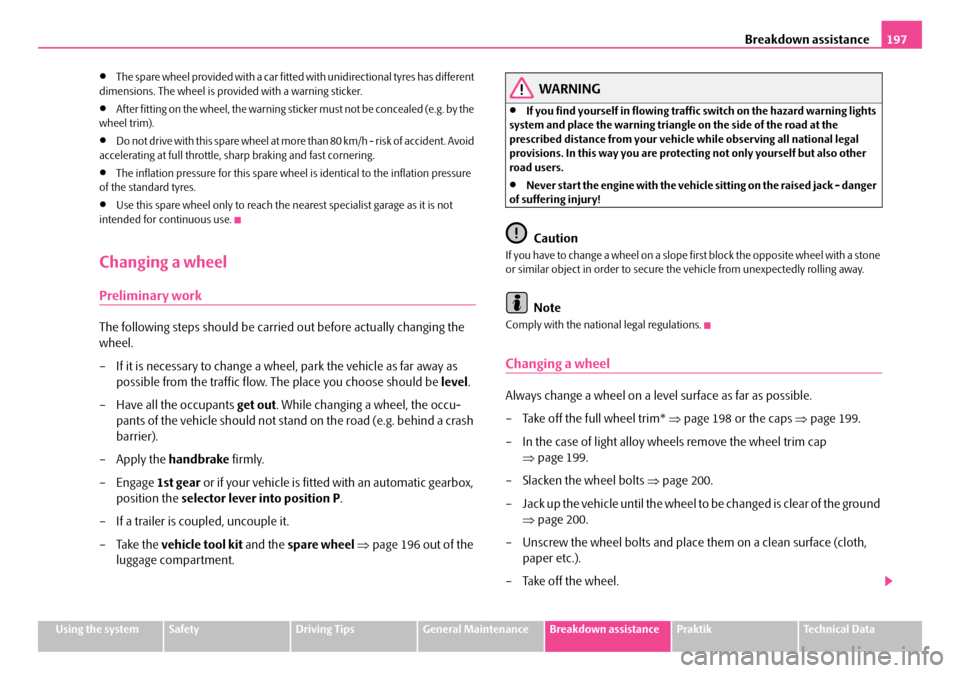
Breakdown assistance197
Using the systemSafetyDriving TipsGeneral MaintenanceBreakdown assistancePraktikTechnical Data
•The spare wheel provided with a car fitted with unidirectional tyres has different dimensions. The wheel is provided with a warning sticker.
•After fitting on the wheel, the warning stic ker must not be concealed (e.g. by the wheel trim).
•Do not drive with this spare wheel at more than 80 km/h - risk of accident. Avoid accelerating at full throttle, sharp braking and fast cornering.
•The inflation pressure for this spare wheel is identical to the inflation pressure of the standard tyres.
•Use this spare wheel only to reach the ne arest specialist garage as it is not intended for co ntinuous use.
Changing a wheel
Preliminary work
The following steps should be carried out before actually changing the
wheel.
– If it is necessary to change a wheel, park the vehicle as far away as
possible from the traffic flow. The place you choose should be level.
– Have all the occupants get out. While changing a wheel, the occu-
pants of the vehicle should not stan d on the road (e.g. behind a crash
barrier).
– Apply the handbrake firmly.
–Engage 1st gear or if your vehicle is fitted with an automatic gearbox,
position the selector lever into position P.
– If a trailer is coupled, uncouple it.
– Take the vehicle tool kit and the spare wheel ⇒page 196 out of the
luggage compartment.
WARNING
•If you find yourself in flowing traffic switch on the hazard warning lights system and place the warning triangle on the side of the road at the prescribed distance from your vehicle while observing all national legal provisions. In this way you are protecting not only yourself but also other road users.
•Never start the engine with the vehicle sitting on the raised jack - danger of suffering injury!
Caution
If you have to change a wheel on a slope first block the opposite wheel with a stone or similar object in order to secure th e vehicle from unexpectedly rolling away.
Note
Comply with the national legal regulations.
Changing a wheel
Always change a wheel on a level surface as far as possible.
– Take off the full wheel trim* ⇒page 198 or the caps ⇒page 199.
– In the case of light alloy wheels remove the wheel trim cap
⇒ page 199.
– Slacken the wheel bolts ⇒page 200.
– Jack up the vehicle until the wheel to be changed is clear of the ground
⇒ page 200.
– Unscrew the wheel bolts and place them on a clean surface (cloth,
paper etc.).
– Take off the wheel.
NKO A05R 20 MR08.book Page 197 Wednesday, March 28, 2007 9:42 AM
Page 199 of 248
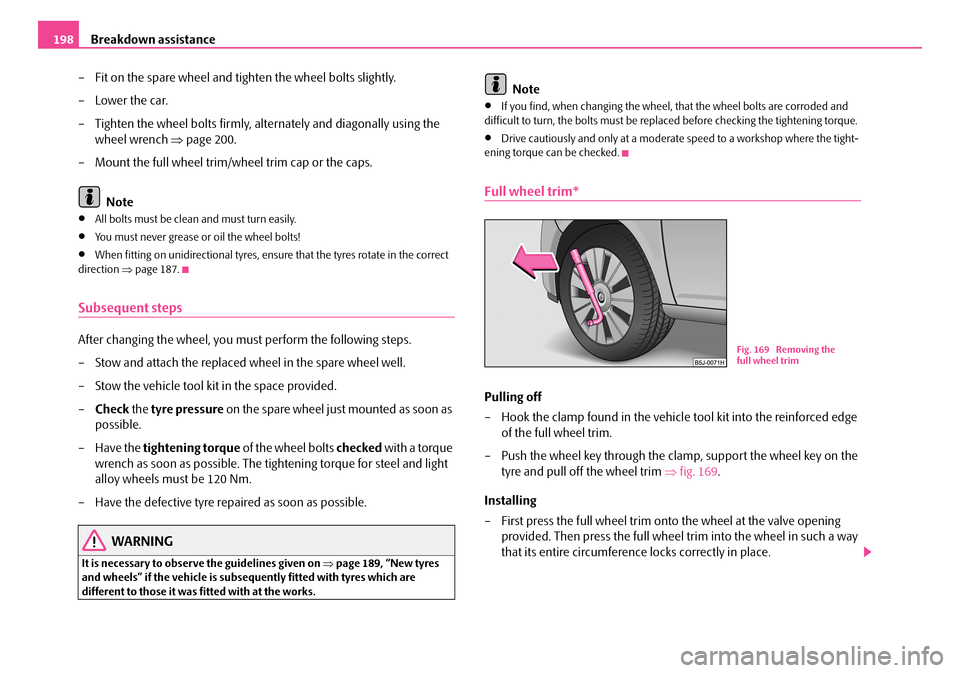
Breakdown assistance198
– Fit on the spare wheel and tighten the wheel bolts slightly.
–Lower the car.
– Tighten the wheel bolts firmly, alternately and diagonally using the
wheel wrench ⇒page 200.
– Mount the full wheel trim/wheel trim cap or the caps.
Note
•All bolts must be clean and must turn easily.
•You must never grease or oil the wheel bolts!
•When fitting on unidirectional tyres, ensu re that the tyres rotate in the correct direction ⇒page 187.
Subsequent steps
After changing the wheel, you must perform the following steps.
– Stow and attach the replaced wheel in the spare wheel well.
– Stow the vehicle tool kit in the space provided.
– Check the tyre pressure on the spare wheel just mounted as soon as
possible.
– Have the tightening torque of the wheel bolts checked with a torque
wrench as soon as possible. The ti ghtening torque for steel and light
alloy wheels must be 120 Nm.
– Have the defective tyre repaired as soon as possible.
WARNING
It is necessary to observe the guidelines given on ⇒page 189, “New tyres and wheels” if the vehicle is subseq uently fitted with tyres which are different to those it was fitted with at the works.
Note
•If you find, when changing the wheel, that the wheel bolts are corroded and difficult to turn, the bolts must be replac ed before checking the tightening torque.
•Drive cautiously and only at a moderate speed to a workshop where the tight- ening torque can be checked.
Full wheel trim*
Pulling off
– Hook the clamp found in the vehicle tool kit into the reinforced edge
of the full wheel trim.
– Push the wheel key through the clamp, support the wheel key on the
tyre and pull off the wheel trim ⇒fig. 169.
Installing
– First press the full wheel trim onto the wheel at the valve opening
provided. Then press the full wheel trim into the wheel in such a way
that its entire circumference locks correctly in place.
Fig. 169 Removing the full wheel trim
NKO A05R 20 MR08.book Page 198 Wednesday, March 28, 2007 9:42 AM
Page 200 of 248
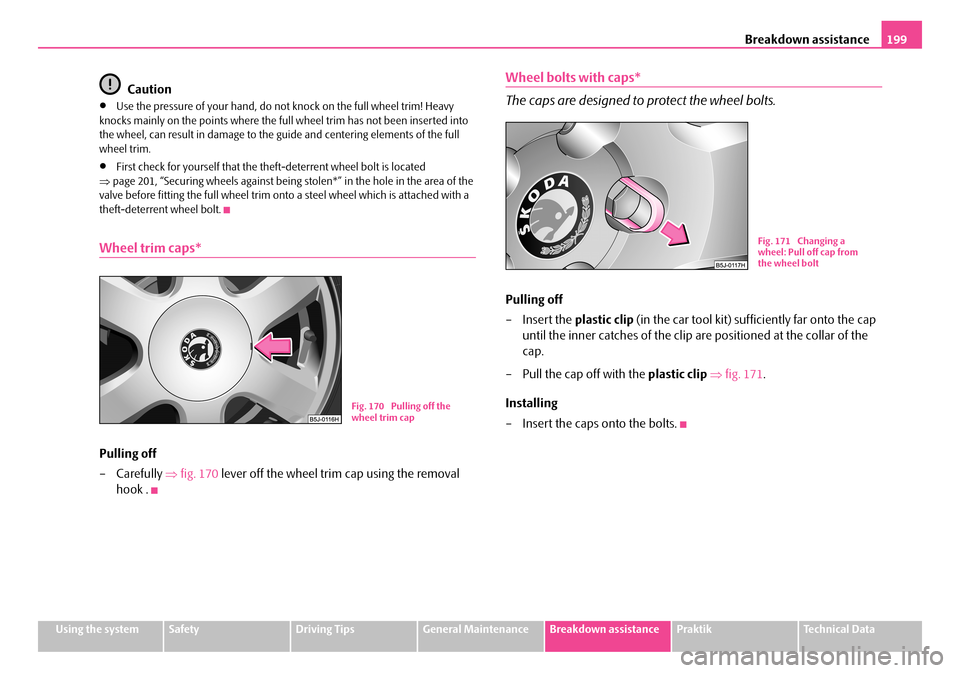
Breakdown assistance199
Using the systemSafetyDriving TipsGeneral MaintenanceBreakdown assistancePraktikTechnical Data
Caution
•Use the pressure of your hand, do not knock on the full wheel trim! Heavy knocks mainly on the points where the full wheel trim has not been inserted into the wheel, can result in damage to the guide and centering elements of the full wheel trim.
•First check for yourself that the th eft-deterrent wheel bolt is located ⇒ page 201, “Securing wheels against being stolen*” in the hole in the area of the valve before fitting the full wheel trim onto a steel wheel which is attached with a theft-deterrent wheel bolt.
Wheel trim caps*
Pulling off
–Carefully ⇒fig. 170 lever off the wheel trim cap using the removal
hook .
Wheel bolts with caps*
The caps are designed to protect the wheel bolts.
Pulling off
– Insert the plastic clip (in the car tool kit) sufficiently far onto the cap
until the inner catches of the clip are positioned at the collar of the
cap.
– Pull the cap off with the plastic clip ⇒fig. 171.
Installing
– Insert the caps onto the bolts.
Fig. 170 Pulling off the wheel trim cap
Fig. 171 Changing a wheel: Pull off cap from the wheel bolt
NKO A05R 20 MR08.book Page 199 Wednesday, March 28, 2007 9:42 AM